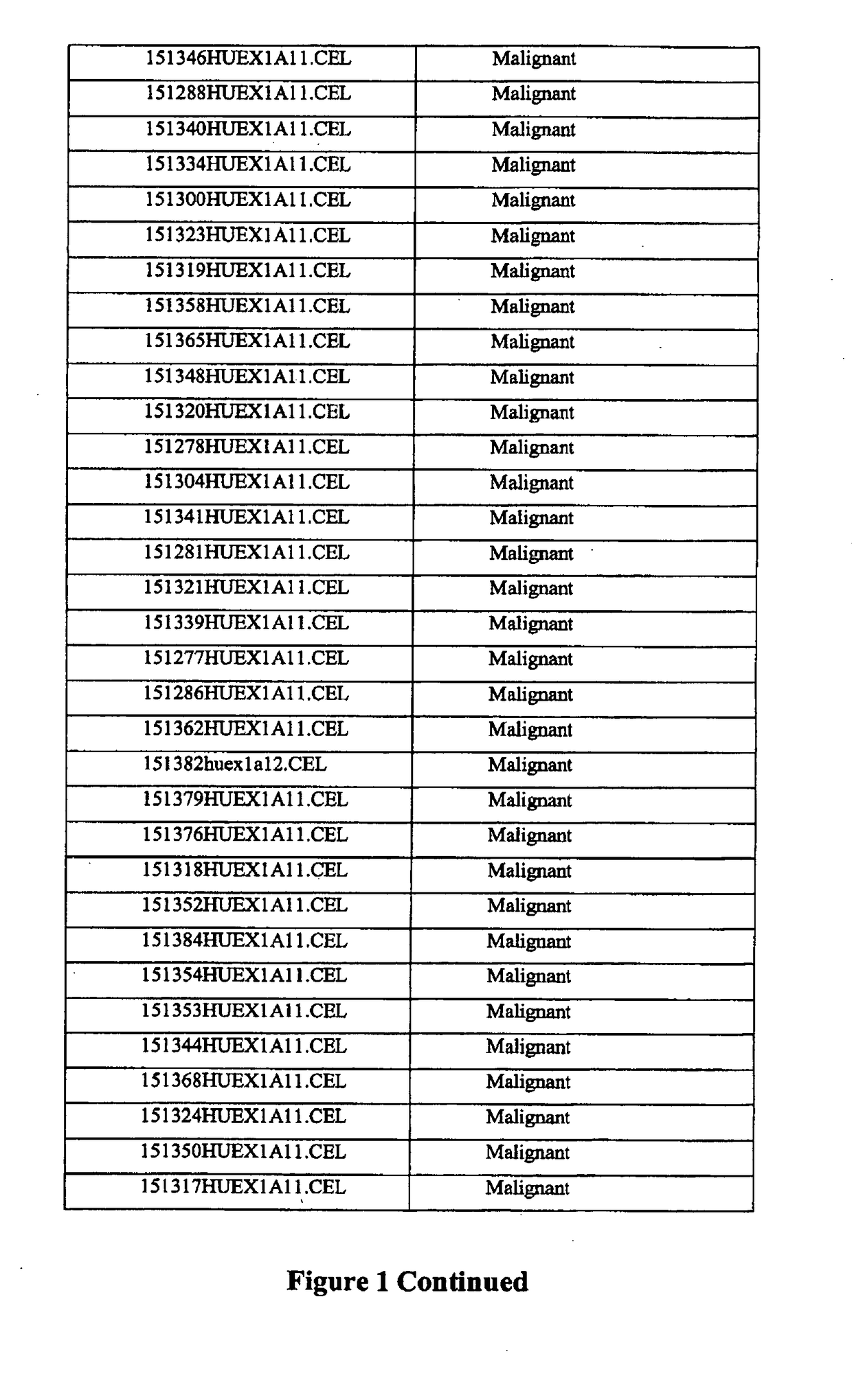Algorithms for disease diagnostics
a disease and algorithm technology, applied in the field of algorithm for disease diagnosis, can solve the problems of no definitive diagnosis, sharp increase in the number of cancers, and inability to diagnose definitively
- Summary
- Abstract
- Description
- Claims
- Application Information
AI Technical Summary
Benefits of technology
Problems solved by technology
Method used
Image
Examples
example 1
Gene Expression Product Analysis of Thyroid Samples
[0335]75 thyroid samples were examined for gene expression analysis using the Affymetrix Human Exon lOST array according to manufacturer's instructions to identify genes that showed significantly differential expression and / or alternative splicing between malignant, benign, and normal samples. Three groups were compared and classified according to pathological surgical diagnosis of the tissue: benign (n=29), malignant (n=37), and normal (n=9). The samples were prepared from surgical thyroid tissue, snap frozen and then the RNA was prepared by standard methods. The names and pathological classification of the 75 samples are depicted in FIG. 1.
[0336]Microarray analysis was run with XRAY version 2.69 (Biotique Systems Inc.),Input files were normalized with full quantile normalization (Irizarry et al. Biostatistics 2003 Apr. 4 (2): 249-64). For each input array and each probe expression value, the array -ith percentile probe value was r...
example 2
Gene Expression Product Analysis of Thyroid Tissue Samples
[0342]A total of 205 thyroid tissue samples (FIG. 7) are examined with an Affymetrix HumanExon10ST array chip to identify genes that differ significantly in RNA expression levels between benign and malignant samples. Samples are classified according to post-surgical thyroid pathology: samples exhibiting follicular adenoma (FA), lymphocytic thyroiditis (LCT), or nodular hyperplasia (NHP) are classified as benign; samples exhibiting Hurthle cell carcinoma (HC), follicular carcinoma (FC), follicular variant of papillary thyroid carcinoma (FVPTC), papillary thyroid carcinoma (PTC), medullary thyroid carcinoma (MTC), or anaplastic carcinoma (ATC) are classified as malignant.
[0343]Affymetrix software is used to extract, normalize, and summarize intensity data from roughly 6.5 million probes. Approximately 280,000 core probe sets are subsequently used in feature selection and classification. The models used are LIMMA for feature sel...
example 4
Bayesian Analysis of Gene Expression Product Data from Thyroid Samples
[0349]Two groups of well-characterized samples are compared in order to identify genes that distinguish benign from malignant nodules in the human thyroid. Samples are derived from surgical thyroid tissue (tissue; n=205, FIG. 7) or from fine needle aspirates (FNA; n=74, FIG. 8) and are examined by hybridization to the HumanExon10ST microarray. Pathology labels for each distinct thyroid subtype are coded as either benign (B) or malignant (M). A total of 499 markers that show distinct differential expression between benign and malignant samples are identified.
[0350]Affymetrix software is used to extract, normalize, and summarize intensity data from approximately 6.5 million probes. Roughly 280,000 core probe sets are subsequently used in feature selection and classification of ˜22,000 genes. The models used are LIMMA (for feature selection) and SVM (for classification) respectively.
[0351]Next, we previously publishe...
PUM
| Property | Measurement | Unit |
|---|---|---|
| Fraction | aaaaa | aaaaa |
| Fraction | aaaaa | aaaaa |
| Fraction | aaaaa | aaaaa |
Abstract
Description
Claims
Application Information
 Login to View More
Login to View More - R&D
- Intellectual Property
- Life Sciences
- Materials
- Tech Scout
- Unparalleled Data Quality
- Higher Quality Content
- 60% Fewer Hallucinations
Browse by: Latest US Patents, China's latest patents, Technical Efficacy Thesaurus, Application Domain, Technology Topic, Popular Technical Reports.
© 2025 PatSnap. All rights reserved.Legal|Privacy policy|Modern Slavery Act Transparency Statement|Sitemap|About US| Contact US: help@patsnap.com



